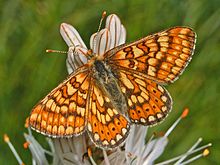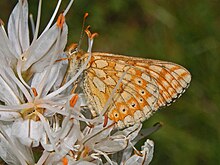Marsh fritillary
| Euphydryas aurinia | |
|---|---|
 |
|
| Upperside | |
 |
|
| Underside | |
| Scientific classification | |
| Kingdom: | Animalia |
| Phylum: | Arthropoda |
| Class: | Insecta |
| Order: | Lepidoptera |
| Family: | Nymphalidae |
| Genus: | Euphydryas |
| Species: | E. aurinia |
| Binomial name | |
|
Euphydryas aurinia (Rottemburg, 1775) |
|
| Synonyms | |
|
List
|
|
The marsh fritillary (Euphydryas aurinia) is a butterfly of the Nymphalidae family.
E. aurinia is represented by many subspecies. The most widely accepted are:
but the total number of described subspecies is much higher especially in the eastern Palaearctic. The insect may be best considered a superspecies.
Euphydryas aurinia aurinia
Euphydryas aurinia beckeri
Euphydryas aurinia provincialis
This species is widespread in the east Palaearctic ecozone from Ireland in the west to Yakutia in the east, and to north-west China and Mongolia in the south. The marsh fritillary is in decline in Europe and it is one of eleven butterflies covered by the United Kingdom Biodiversity Action Plan. Within the British Isles, it is more frequent in the south and west.
This species lives in calcareous grassland, in woodland clearings and in damp marshy areas (hence the common name) and in heathy grassland, dominated by tussock forming grasses, including purple moor and rush pastures. These butterflies can reach an elevation of 10–2,200 metres (33–7,218 ft) above sea level.
In the British Isles the marsh fritillary is usually to be found in damp heathy grasslands which are called rhos pastures from the Welsh word rhos meaning heath, but the species does exist in other types of habitats which are drier, like neutral grasslands or dry calcareous grasslands. Small populations may be seen where there is not a lot of the larval food plant present. Small populations can be an important element of the ecology because they can produce lots of mobile individuals which can found other populations. The marsh fritillary is protected under British law. It is listed under Schedule 5 of the Wildlife and Countryside Act, also the EU Habitats and Species Directive (Annex II).
...
Wikipedia
